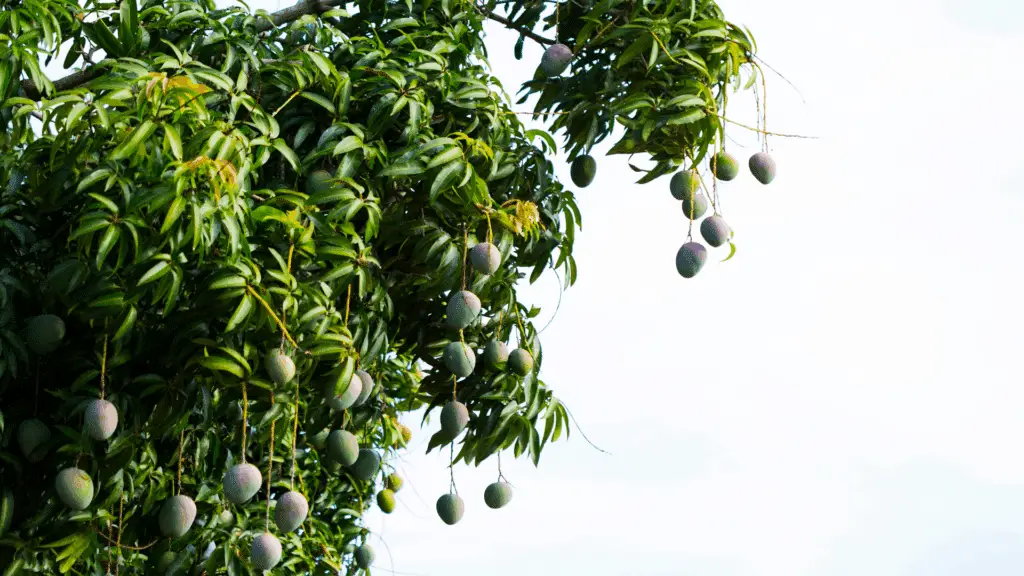Mango is a versatile wood that originates in tropical zones like Southeast Asia and South America. It is prized for its beautiful color patterns and ability to be sculpted into intricate shapes. But is it good for furniture?
Mango wood is good for furniture because it is sustainable, resistant to water, colorful, soft, easy to work, and affordable. However, mango wood is vulnerable to fungus and insects, so it must be treated. You also need to perform regular maintenance, and it may cause allergic reactions.
In this guide, we cover all the pros and cons of using mango wood as furniture to make an informed choice when you are planning or thinking of doing so. Read on.
Craft Gecko is supported by its audience. When you purchase through links on our site, we may earn an affiliate commission, at no additional cost to you.
It Is Sustainable
Mango wood is sustainable and eco-friendly. This makes it a great option if you are worried about your ecological footprint or global shrinking forests.
Mango trees are common in the tropical zones of Asia, Latin America, and Australia. This means that there is little economic pressure for just one area to mass-produce mango fruit or wood.

The trees are usually planted to harvest the fruit. The wood is a by-product of this process. Mango trees can grow as much as 100 feet (30.5m) in 15 years, so they grow quickly after being chopped and harvested. Farmers also quickly replace the trees to continue the fruit harvesting process.
Because the trees grow so quickly, they need minimal upkeep and resources. Furthermore, it is difficult for growers to harvest fruit from the tallest trees. Therefore, chopping down the tallest trees is both a logical step and an excellent mango wood source.
Mango trees are also beneficial for the soil. They help to keep moisture in the soil, which can benefit dry regions with multiple crops.
Overall, mango wood’s farming process is more beneficial for the environment than many other furniture-grade kinds of wood.
It Is Water-Resistant
Mango wood is resistant to water. Because of its density, it does not allow water to penetrate its surface easily.
This makes it ideal for outdoor furniture like tables, chairs, and benches. While you should still use furniture covers in heavy rain, mango wood can resist wet weather without rotting. This is important if you live in a tropical climate.

Water-resistance also makes it an excellent option for kitchen or bathroom furniture. You can expose your mango wood furniture to steam and condensation without damaging it.
It Is Colorful
Mango wood is available in multiple colors and patterns, including:
- Golden brown
- Yellow
- Pink
- Black
- Mottled pattern
The color variation of mango wood is due to a process called spalting. Different fungus varieties grow inside the wood and change its color through pigmentation, white rot, or zone lines.
Pigmentation occurs when fungi create pigments inside of the wood. This directly changes the color of the wood that it is growing on. Zone lines are dark lines in wood that result from different fungi creating barriers. White rot is not common in mango wood.
Because of the unusual color patterns, mango wood is perfect for statement pieces in the home. It can excel as decorative furniture that shows off aesthetics as much as functionality.
However, this could be a disadvantage if you are looking for a symmetrical furniture set. It is unlikely that all mango wood pieces will be identical in color and wood grain pattern.
It Is a Soft Hardwood
Mango wood is a hardwood. It has a Janka hardness scale of 1,070 lbf (4,780 N). This score describes how resistant wood is to damage and pressure and has a similar hardness to cherry and ash.
Because mango wood is hard, it is durable and resistant to damage. However, it is still flexible, elastic, and easy to mold. Mango wood does not splinter or crack easily.
For this reason, it is an excellent candidate for furniture. You can sculpt mango wood into different shapes and designs. While this softness makes mango wood a poor choice for flooring, it is suitable for statement pieces and ornate furniture.
It also absorbs stains and finishes so that woodworkers can create a darker effect for more sophisticated furniture.
You can see how easy it is to make a table with mango wood in the following video:
It Is Affordable
Mango wood is a great choice for unique furniture that looks unique without costing a fortune. It is considerably cheaper than premium woods like oak or teak.
Because it is grown in multiple regions of the world, there is always a steady wood supply. This keeps prices low and furniture affordable.
It Is Vulnerable to Fungus and Insects
As previously discussed, mango wood often naturally has fungus growing inside of it. This creates exciting color patterns that make the wood so attractive. However, excess or uncontrolled fungal growth can cause the wood to rot.
Mango trees also attract a variety of insects that target the fruit, leaves, and wood. The mango wood is vulnerable to the following pests:
- Mango tree borers: These are small insects that cut holes into the wood and penetrate the surface. They lay their eggs inside the wood, which hatch and continue the process.
- Scolytid beetles: These small beetles feed on the wood and cause rot and color change of color. They usually target weaker wood but can quickly establish a large infestation.
Furniture makers first dry mango wood to protect it from fungus and insects. They also apply a finish for further protection. You might like to add your coating to maintain your mango wood furniture. A water-based lacquer finish like the Watco 63041 Lacquer Clear Wood Finish is a good option.
- Ideal for use on furniture, doors, cabinets and paneling; not recommended for floors or exterior surfaces
- Formulated for a higher clarity finish than polyurethane
- Dries to the touch in 1 hour and covers up to 290 sq ft
Last update on 2023-06-13 at 22:21 / Affiliate links / Images from Amazon Product Advertising API
Mango Wood Furniture Needs Regular Maintenance
Because of its moisture resistance, mango wood is vulnerable to dehydration. This can cause the furniture to crack, which is both unattractive and a potential hazard. Cracked wood can split and break, which could put you in danger.
You should polish and hydrate mango wood once a week to prevent this from happening. We recommend the Kango Mango Wood Polish-mate, which is designed for natural woods.
- NEW and Easy to use. Nourishes & protects dry wood. Keep your wood furniture polished regularly to bring out its natural beauty.
- Suitable for any type of natural wood products from kitchen chopping blocks to indoor/outdoor furniture.
- Apply a thin layer with a clean cloth then buff to shine and let dry between applications. A little goes a long way.
Last update on 2023-06-13 at 22:21 / Affiliate links / Images from Amazon Product Advertising API
It Can Cause Allergic Reactions
Mango wood might not be a good option for your furniture if you are prone to allergic reactions. It is a mild-moderate irritant that can affect your hands. This could cause a rash or painful reaction if you touch the wood.
While this is an uncommon allergy, it might be worth testing your response before buying mango wood furniture. You can try touching some in a furniture store and waiting for 48 hours to see if your skin has an allergic reaction.
Summary
This wood is a great option because it is eco-friendly and sustainable, resistant to water, attractive with a dense grain, soft and easy to mold, and affordable. It is also appropriate for a wide variety of indoor and outdoor furniture.
The main drawback of mango wood is that it is vulnerable to insects and fungal damage. Therefore, you must treat the wood before using it as furniture. However, this is a simple process. You also need to perform regular maintenance to avoid dehydration of the wood.
Mango wood also has a small risk of causing irritating allergic reactions. You should be careful if you usually have an allergic reaction to wood or plants.
Overall, with a small amount of effort, you can make mango wood suitable for any furniture.
Sources
- Trade Furniture Company: Why Mango Wood is the Sustainable Choice for Furniture
- FAO: Time is running out for the world’s forests: total area is shrinking by the day
- Thomson Reuters Foundation News: Arid Kenya swaps charcoal burning for mango farming
- Boast Design: The Benefits of Mango Wood Furniture
- Wood Database: Mango
- Wikipedia: Spalting
- Wikipedia: Janka hardness test
- Casa Bella Furniture: Mango Wood Furniture
- World Interiors: Mango Wood Furniture in Austin
- Plant Village: Mango
- University of Florida: ENY-413/1G073: Mango Pests and Beneficial Insects
- YouTube: Making a Mango Dining Table
- Wood Database: Wood Allergies and Toxicity
